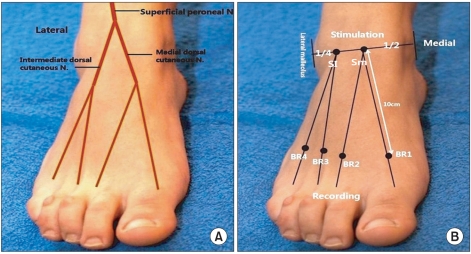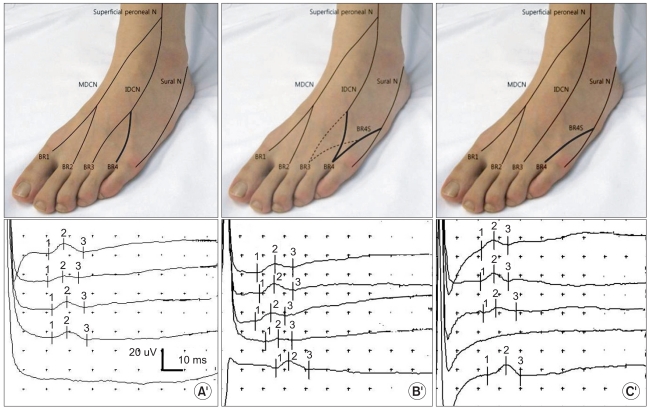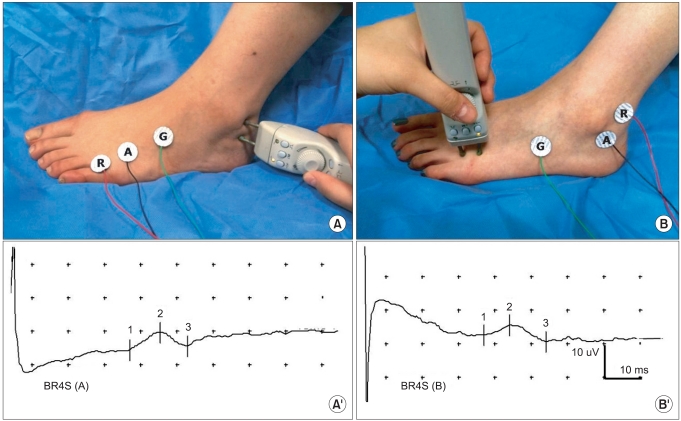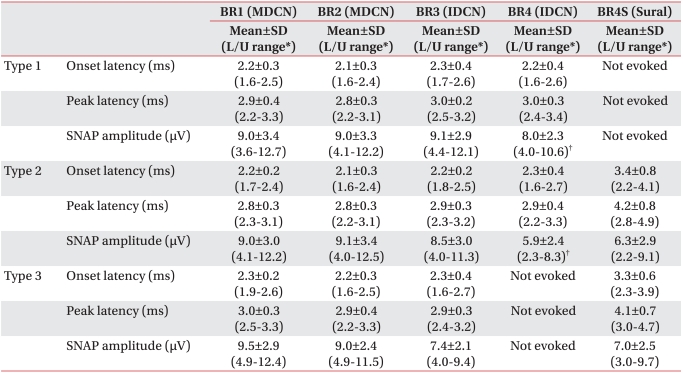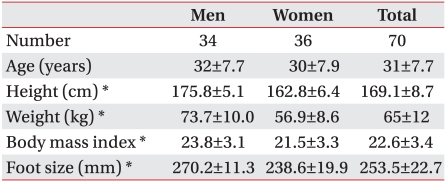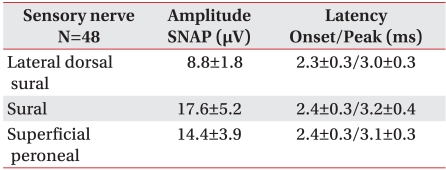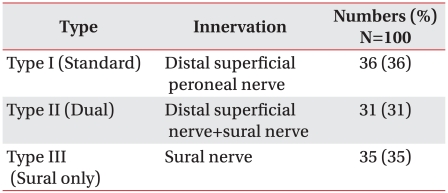1. Burke D, Skuse NF, Lethlean AK. Sensory conduction of the sural nerve in polyneuropathy. J Neurol Neurosurg Psychiatry 1974;37:647-652. PMID:
4367408.



2. Braddom RL, Hollis JB, Castell DO. Diabetic peripheral neuropathy: a correlation of nerve conduction studies and clinical findings. Arch Phys Med Rehabil 1977;58:308-313. PMID:
880006.

3. Celiker R, Basgze O, Bayraktar M. Early detection of neurological involvement in diabetes mellitus. Electromyogr Clin Neurophysiol 1996;36:29-35. PMID:
8654318.

4. Ryu GH, Nam KY, Jun JY, Sim YJ, Choi JH, Kwon BS, Park JW, Lim HS. New method and usefullness of study on sensory nerve conduction of lateral sural cutaneous Nerve. J Korean Acad Rehab Med 2008;32:300-304.
5. Uluc K, Isak B, Borucu D, Temucin CM, Cetinkaya Y, Koytak PK, Tanridag T, Us O. Medial plantar and dorsal sural nerve conduction studies increase the sensitivity in the detection of neuropathy in diabetic patients. Clin Neurophysiol 2008;119:880-885. PMID:
18291716.


6. Andersen H, Stlberg E, Falck B. F-wave latency, the most sensitive nerve conduction parameter in patients with diabetes mellitus. Muscle Nerve 1997;20:1296-1302. PMID:
9324086.


7. Jabre JF. The superficial peroneal sensory nerve revisited. Arch Neurol 1981;38:666-667. PMID:
7295115.


8. Lo YL, Xu LQ, Leoh TH, Dan YF, Tan YE, Nurjannah S, Ratnagopal P. Superficial peroneal sensory and sural nerve conduction studies in peripheral neuropathy. J Clin Neurosci 2006;13:547-549. PMID:
16678425.


9. Kushnir M, Klein C, Kimiagar Y, Pollak L, Rabey JM. Medial dorsal superficial peroneal nerve studies in patients with polyneuropathy and normal sural responses. Muscle Nerve 2005;31:386-389. PMID:
15508123.


10. Izzo KL, Sridhara CR, Rosenholtz H, Lemont H. Sensory conduction studies of the branches of the superficial peroneal nerve. Arch Phys Med Rehabil 1981;62:24-27. PMID:
7458628.

11. Levin KH, Stevens JC, Daube JR. Superficial peroneal nerve conduction studies for electromyographic diagnosis. Muscle Nerve 1986;9:322-326. PMID:
3012328.


12. Oh SJ, Demirci M, Dajani B, Melo AC, Claussen GC. Distal sensory nerve conduction of the superficial peroneal nerve: new method and its clinical application. Muscle Nerve 2001;24:689-694. PMID:
11317280.


13. Kosinski C. The course, mutual relations and distribution of the cutaneous nerves of the metazonal region of leg and foot. J Anat 1926;60:274-297. PMID:
17104102.


14. Solomon LB, Ferris L, Tedman R, Henneberg M. Surgical anatomy of the sural and superficial fibular nerves with an emphasis on the approach to the lateral malleolus. J Anat 2001;199:717-723. PMID:
11787825.



15. Ko YJ, Kim HY, Park NK, Kim JK, Jang JY, Kang SY. Conduction study of dorsomedial cutaneous nerve to the great toe. J Korean Acad Rehabil Med 1998;22:1284-1287.
16. Liveson JA, Ma DM. Laboratory reference for clinical neurophysiology. 1992.1st ed. New York: Oxford; p.219-226.
17. DiBenedetto M. Sensory nerve conduction in lower extremities. Arch Phys Med Rehabil 1970;51:253-258. PMID:
4315972.

18. Lee HJ, Bach HJ, DeLisa JA. Lateral dorsal cutaneous branch of the sural nerve. Standardization in nerve conduction study. Am J Phys Med Rehabil 1992;71:318-320. PMID:
1466868.


19. Dorfman LJ, Robinson LR. AAEM minimonograph # 47: normative data in electrodiagnostic medicine. Muscle Nerve 1997;20:4-14. PMID:
8995577.


20. Campbell WW, Robinson LR. Deriving reference values in electrodiagnostic medicine. Muscle Nerve 1993;16:424-428. PMID:
8455658.


21. Resman-Gaspersc A, Podnar S. Phrenic nerve conduction studies: technical aspects and normative data. Muscle Nerve 2008;37:36-41. PMID:
17763457.


22. Drake RL, Vogl W, Mitchell AW. Gray's anatomy for students. 2005.39th ed. Philadelphia: Chrchill Livingstone; p.582-584.
23. Kimura J, Murphy MJ, Varda DJ. Electrophysiological study of anomalous innervations of intrinsic hand muscles. Arch Neurol 1976;33:842-844. PMID:
999546.


24. Bolton CF, Carter KM. Human sensory nerve compound action potential amplitude: variation with sex and finger circumference. J Neurol Neurosurg Psychiatry 1980;43:925-928. PMID:
7441272.



25. Falco FJ, Hennessey WJ, Braddom RL, Goldberg G. Standardized nerve conduction studies in the upper limb of the healthy elderly. Am J Phys Med Rehabil 1992;71:263-271. PMID:
1388972.


26. Stetson DS, Albers JW, Silverstein BA, Wolfe RA. Effects of age, sex, and anthropometric factors on nerve conduction measures. Muscle Nerve 1992;15:1095-1104. PMID:
1406766.


27. Trojaborg WT, Moon A, Andersen BB, Trojaborg NS. Sural nerve conduction parameters in normal subjects related to age, gender, temperature, and height: a reappraisal. Muscle Nerve 1992;15:666-671. PMID:
1308101.


28. Zwarts MJ, Guechev A. The relation between conduction velocity and axonal length. Muscle Nerve 1995;18:1244-1249. PMID:
7565920.


29. Killian JM, Foreman PJ. Clinical utility of dorsal sural nerve conduction studies. Muscle Nerve 2001;24:817-820. PMID:
11360266.


30. Izzo KL, Sobel E, Demopoulos JT. Diabetic neuropathy: electrophysiologic abnormalities of distal lower extremity sensory nerves. Arch Phys Med Rehabil 1986;67:7-11. PMID:
3942492.

31. Sridhara CR, Izzo KL. Terminal sensory branches of the superficial peroneal nerve: an entrapment syndrome. Arch Phys Med Rehabil 1985;66:789-791. PMID:
4062533.

32. Nelson GA, Puhl RW, Altman MI. Superficial dysesthesias secondary to epidermoid cyst of the foot. J Foot Surg 1985;24:269-271. PMID:
4045117.

33. Acus RW 3rd, Flanagan JP. Perineural fibrosis of superficial peroneal nerve complicating ankle sprain: a case report. Foot Ankle 1991;11:233-235. PMID:
1906831.


34. Preston D, Logigian E. Iatrogenic needle-induced peroneal neuropathy in the foot. Ann Intern Med 1988;109:921-922. PMID:
2847612.


